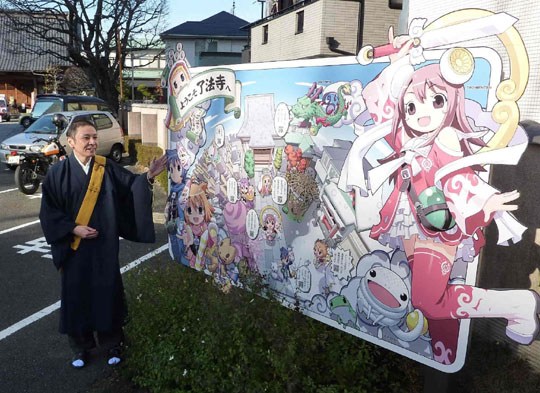In the current state of religious affairs, the concept of “lived religion” brought to us by Meredith McGuire in her latest book “Lived Religion: Faith and Practice” appears to be a highly relevant one, and most certainly, a fascinating one. It made me think about the manifestations of personal religiosity and the role of institutional engagement in shaping them in the Japanese context. It also brings to mind the notion of being “practically religious” in Japanese Buddhism and beyond. Ian Reader and George J. Tanabe, in their book Practically Religious (1998), argue that “Japanese religion is less a matter of belief than it is of activity, ritual, and custom”[1] and “the promise of this-worldly benefits is an intrinsic element within Japanese religion in general”.[2] In other words, Japanese religiosity is not necessarily based on what one believes in, but rather on what one does or should do and what one can get out of such activities, regardless of whether the fruits are of a spiritual or material nature.
Hence, it is a promise of some kind that lures people into visiting religious sites. For those who seek spiritual support, it might be a promise of deities’ protection against an illness or reassurance of peace for their ancestors’ spirits, which is bought with the offerings for prayers and fees paid for protective o-mamori (amulets). Yet, for those looking for a place to relax, escape their daily routine and experience something exciting, temples and shrines need to invent new ways to satisfy that need, especially at the time when more people claim to have little or no religious affiliation, and when visiting shrines and temples became associated with cultural and tourist activities rather than with religious activities. An increasing number of Japanese people today, especially young, visit famous religious sites for exclusively recreational reasons.
The number of Japanese people claiming lack of religious belief increased to 80% in the post-Aum era,[3] whereas the number of people admitting to have some sort of religious belief is no more than 20-30% and even lower among university students.[4] The semi-structured interviews I conducted in November and December 2009 among 86 Kyoto University students[5] revealed that all of them described their religious belief as mushūkyō (“non-religious”), only three of them identified their religious affiliation as Buddhist (mainly due to their family affiliation), and 84 confirmed that they visit temples and shrines on various occasions during the year, including hatsumōde, ō-bon celebrations and cherry blossoms viewings, and usually during their visits they purchase o-mamori (protective talismans) and o-mikuji (written oracle). My interviewees stated three main reasons for those visits, dentō (tradition), nihonjin-no koto (this is what Japanese people do), and tomodachi-to asobu toki (fun time with friends).
None of the interviewees mentioned their spiritual needs, whereas all put a stress on cultural and entertaining aspects of their visits to Buddhist temples. This may hint that young people in particular have low levels of religious affiliation; however this does not mean that they have no connection with religious places. It appears that visiting shrines and temples by young people is a widespread activity, yet the importance of ‘religious’ or ‘spiritual’ motivations is rarely if at all highlighted. It appears that this notion of Japanese practicality in one’s personal engagement with religion may somewhat distort the concept of “lived religion” or “religion as lived” understood by McGuire as a subjective experience. Yet, perhaps this practical or action-based approach of engagement allows people to nurture their subjective experiences of faith without necessarily revealing their personal motivations behind their practices.
On the other hand McGuire discusses the malleability of religion (especially that personal one) and the “pic and mix” nature of “lived religion” with people drawing from a number of different religious traditions for practices and teachings. The very notion of malleability in this context brought my thinking to the ongoing discussion of change in religious traditions, institutions, and personal practices. This again brings me to my area of research in Japan where many institutions, including Japanese Buddhist temples, adapt to facilitate the religious engagement and its financial survival.
Along with the modernisation and commercialisation of society came the necessity to adapt to the new cultural, social and economic conditions; and this is true for all religious traditions in Japan. When Buddhism first arrived in Japan in the 6th century, it also needed to convince both the ruling class and the people that it was in tune with local spiritual traditions. The Buddhist concept of hōben (skillful means) allows us to understand the secret of religious adaptability in Japan today. Skillful means, in Buddhist terms, represents the idea of not always telling the truth, as long as it helps people in achieving enlightenment, or as it can be understood today, as long as it helps people and attracts potential visitors to temples and shrines. The concept of “untruth” understood in terms of hōben is perpetrated for the sake of others and with the use of any means available at the time which can contribute to the popularisation of a particular practice or religious site.
It can be suggested that religious organisations in Japan today are likely to resort to the use of modern hōben methods such as a wide range of advertising techniques and use of technology in the context of the economic and social changes that affected them after the promulgation of the new constitution in 1946. Through the variety of those advertising techniques and imagery of religious sites promoted with them, I would argue that the emphasis on entertainment themes and the shift from religious to tourist activities associated with visits to Buddhist temples has become especially evident in commercial advertising of the recent years. However, it is essential to understand that the idea of blending of religion and entertainment is not a product of postmodern consumption-driven society and has long-established roots in Japanese religious tradition. It is only in recent years, however, that the notion of fun managed to dominate the sphere of the religious. It may be suggested that Buddhist temples in Japan are also undergoing a process of experimentation and subjectivity of experience associated with the notion of “lived” as opposed to “preached” religion. How these changes impact on the identities of people living in local communities is something that I would like to explore in the future.
[1] Reader, Ian. and Tanabe Jr., George J. (1998) Practically Religious: Worldly Benefits and the Common Religion of Japan. Honolulu: University of Hawai’i Press., pp.7
[2] Reader, Ian. and Tanabe Jr., George J. (1998) Practically Religious: Worldly Benefits and the Common Religion of Japan. Honolulu: University of Hawai’i Press., pp.8
[3] Dorman, Benjamin. and Reader, Ian, (2007) “Projections and Representations of Religion in Japanese Media”, Nova Religio: The Journal of Alternative and Emergent Religions February 2007 10/3 pp.6-13
[4] Tanatsugu, Masakazu. and Yamanaka, Hiroshi. 棚次 正和 / 山中 弘 2007 宗教学入門 (Introduction to Religious Studies) (東京:ミネルヴア書房)
[5] These are the findings of the semi-structured interviews I conducted in November and December 2009 among 86 Kyoto University students during my stay in Japan in 2009-2010. Although the sampling of my research was limited in number, it can still be argued that these numbers provide an evidence for rather secular attitudes towards religious practices permeating in postmodern Japanese society.



